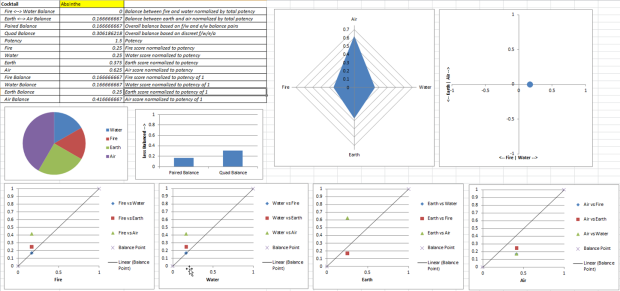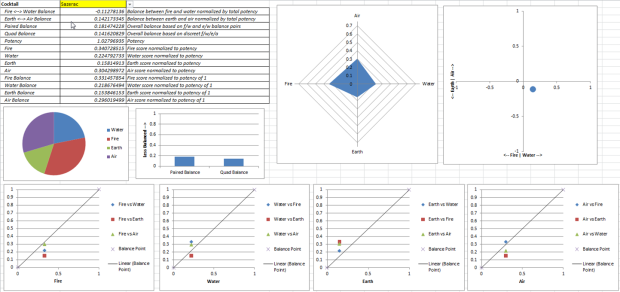How might the prototypical alchemist go about designing the perfect cocktail? It would seem to me that they might start by defining the nature of each ingredient and expect the cocktail to be the composite nature of its parts. While somewhat tongue-in-cheek, I was interested to see what I would learn by taking to completion the premise of classifying cocktail ingredients by their elemental nature. I defined the elemental aspects as follows:
- Fire: Harasses your senses: Bitter, Acidic, Harsh, Caustic, Burning
- Water: Lulls your senses: Sweet, Cool, Soft, Syrupy, Creamy
- Earth: Grounds your sense: Woody, Earthy, Hearty, Body, Dirty
- Air: Tingles your senses: Fragrant, Ethereal, Effervescent, Aromatic, Playful
For a representative base, I transcribed (by hand, yuck) every cocktail and ingredient in the International Bartenders Association’s Official Cocktails list (77 cocktails). I then cleaned up and harmonized all the raw data and imported into a database for analysis. I then rated each of the 93 ingredients shared amongst these cocktails on how much of its nature was represented by each of the 4 elements. Each element of each ingredient was rated with scores as follows:
- 0: None
- 1: Subtle
- 2: Mild
- 3: Moderate
- 4: Strong
- 5: Extreme
As you will see in the example below I divided each rating by the total rating for the ingredient to arrive at a value between 0 and 1 for each element. This allows the rating to nicely describe the balance of the elements within the ingredient and we can easily scale the value later. At this point the objective is about the balance and not their absolute magnitudes.
Example: Absinthe
- Fire = 2. It is potent no doubt but it is not abusive in its nature to my senses.
- Water = 2. It has sweet soothing herbal elements that linger.
- Earth = 3. As a principally herbal tincture it has strong earthy qualities.
- Air = 5. Above all else it is titillating to the nose and tongue with ethereal aromas and tingly tastes.
- Total = 12
-
Fire = 2/12 = 0.17, Water = 2/12 = 0.17, Earth = 3/12 = 0.25, Air = 5/12 = 0.42. (0.17 + 0.17 + 0.25 + 0.42 = 1.00, check)
Now I rated the potency of the ingredient as follows and scaled the ratings up to this potency.
- 1: Weak Ingredient (x 0.25)
- 2: Mild Ingredient (x 0.25)
- 3: Normal Ingredient (x 1.00)
- 4: Strong Ingredient (x 1.25)
- 5: Overpowering Ingredient (x1.50)
Example: Absinthe
- Potency = 5: Overpowering (x1.5). There is a reason you can just wash a glass with this spirit and it still plays an active role in the cocktail.
- Fire = 0.17 * 1.5 = 0.25, Water = 0.17 * 1.5 = 0.25, Earth = 0.25 * 1.5 = 0.38, Air = 0.42 * 1.5 = 0.63. (0.25 + 0.25 + 0.38 + 0.42 + 0.63 = 1.50, check)
With all the ingredients rated I then summed them up by cocktail. In the process I needed to normalize all the measurements (teaspoon, dash, CL, Oz) and also take the final elemental ratings at the cocktail level and divide by the volume of the cocktails so that the final ratings can be compared across cocktails despite their differences in volume. Along the way I invented some jargon by defining a couple new types of measurements. These measurements are a little heavy, feel free to skip past their descriptions if your eyes begin to glaze over!
- Fire/Water Balance and Earth/Air Balance: The objective is to draw a quadrant chart with a single dot that represents where the ingredient or cocktail is on the spectrums of fire vs water and earth vs air where the value is normalized by the overall potency. If you follow this will allow me to treat fire/water as an x coordinate and earth/air as a y coordinate with perfect balance at 0,0 and the two are both normalized by the total potency. The math is as follows for fire/water balance: ((Water – Fire) / (Water + Fire)) * ((Water + Fire)/(Potency)).
- Paired Balance: This is a numerical value for how balanced the cocktail is based on its fire/water balance and earth/air balance. This is accomplished by taking the vector distance from the origin across these two dimensions: Sqrt(FireWaterBalance^2 + EarthAirBalance^2).
- Quad Balance: This is similar to the Paired Balance but reflects the notion that perhaps fire/water and earth/air are not necessarily true opposites. This is accomplished by treating each element as a discreet dimension and taking it’s 4 dimensional vector length with respect to its potency: Sqrt(((Potency/4 -Fire)^2+((Potency/4)-Water)^2+((Potency/4)-Earth)^2+((Potency/4)-Air)^2).
- Fire, Water, Earth, Air Balance: Similar to initially normalizing the ingredients to 1, this is simply the fire, water, earth and air values of the cocktail normalized to a potency of 1 rather than the composite potency of the cocktail based on its ingredients and volumes.
Finally I dropped all this data from the database to an analysis excel document that takes all of these values and displays them graphically in a number of ways to illustrate the nature of the cocktail or ingredient. Below is a screenshot of Absinthe as an ingredient and a Sazerac as a cocktail. I expect that many may question my ratings which are of course entirely subjective. Truth be told, I am certain that were I to rate them all again starting from scratch I would probably end up with some different scores. I will post links to all of this material, I encourage you to explore, tinker and post your findings!


So what did I learn? Short answer, I am not sure yet. I did NOT find evidence that a drink needs to be Balanced, elementally speaking, to be good. This is disappointing because I had intended to next develop software to “invent” drinks constrained by having them result in being elementally balanced. I do feel though that the cocktail elemental ratings do seem to describe the drink very well meaning that they truly are the elemental sum of their parts which is interesting. What is also interesting is that I am seeing some relationships between surprising cocktails that share similar elemental profiles but different ingredients. There is a tab called “Cocktail Proximity Matching” in the analysis excel workbook that allows you to select a cocktail and rank the other 77 by elemental proximity to it.

Sometimes the most pointless inquiries lead to the most interesting and unexpected findings. I am not sure I can cite this as an example yet, but maybe it inspires someone to take a new perspective on the methodology of cocktail creation